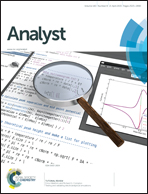KRAS mutation screening by chip-based DNA hybridization – a further step towards personalized oncology†
Abstract
The use of predictive biomarkers can help to improve therapeutic options for the individual cancer patient. For the treatment of colon cancer patients with anti-EGFR-based drugs, the KRAS mutation status has to be determined to pre-select responders that will benefit from this medication. Amongst others, array-based tests have been established for profiling of the KRAS mutation status. Within this article we describe an on-chip hybridization technique to screen therapeutic relevant KRAS codon 12 mutations. The DNA chip-based platform enables the reliable discrimination of selected mutations by allele-specific hybridization. Here, silver deposits represent robust endpoint signals that allow for a simple naked eye rating. With the here presented assay concept a precise identification of heterozygous and homozygous KRAS mutations, even against a background of up to 95% wild-type DNA, was realizable. The applicability of the test was successfully proven for various cancer cell lines as well as clinical tumour samples. Thus, the chip-based DNA hybridization technique seems to be a promising tool for KRAS mutation analysis to further improve personalized cancer treatment.


 Please wait while we load your content...
Please wait while we load your content...